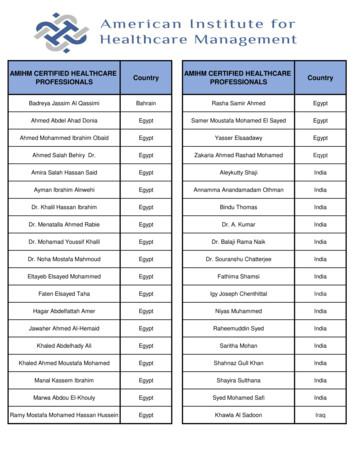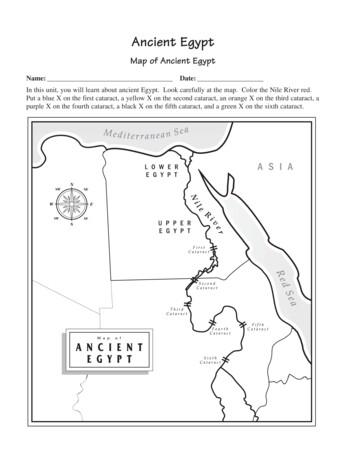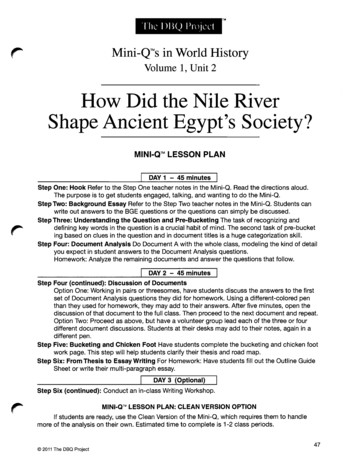Ancient Egypt Research Project - D837868
Name Date PeriodAncient Egypt Research ProjectProject Due Date My Presentation DateDescriptionDuring our study of Ancient Egypt, you will research a specific topic, complete a researchorganizer, and create a PowerPoint presentation. Each research project must have a minimumof 3 sources from which you have found information, with at least one source being from paper.Each student will have a maximum of five minutes to present his or her PowerPoint to the class.RequirementsYou will be graded on your use of class time, your PowerPoint, a peer review, and the oralpresentation of your PowerPoint. See the rubric at the end of this document for details.Each PowerPoint must have a minimum of 7 slides and a maximum of 10 slides. The first slidemust be a Title slide with the title of your project, your name, your class period, and the monthand year in which you completed the project. At least 3 of the next slides must present keyideas from your research. You must incorporate at least 3 graphics or photographs into thepresentation. The last slide must be a bibliography of the sources you used for yourpresentation. All information must be properly cited using the proper citation method. See theexample PowerPoint included here for more information.Possible Research Topics (If you do not like any of these, see me. We’ll work something out.) Gods & GoddessesPyramidsAnimals of the NileThe SphinxRosetta StoneClothingArtTradeMedicine PharaohsMummiesValley of the KingsSocial ClassesFarming and the NileFood and DrinkGeographyTransportationTechnology HieroglyphicsMilitarySlaveryRole of WomenDwellingsJewelryGovernment and LawsAstronomyEducationWrite your 1st, 2nd, and 3rd choice of research topic in the spaces below. You must selectthese topic choices no later than .1st Choice2nd Choice3rd Choice
What’s in this OrganizerProject Cover Page – (the page before this one) A listing of the Description, Requirements, andpossible Topics for the Ancient Egypt Research ProjectSample PowerPoint - “Ancient Egyptian Transportation” an example created by Mr. MeliaBibliography Organizer – How the Bibliography for “Ancient Egyptian Transportation” wascreated and a Blank Template for you to use to collect the bibliography information you willneed for your PowerPointSixth Grade Bibliography Page – A two page reference document that describes how eachsource should be listed in your PowerPoint bibliographyPowerPoint Notes Pages – Three pages of blank PowerPoint slides with an area for notes. Usethese to draft the content for your PowerPointPeer Review Evidence Page – You must have your PowerPoint reviewed by at least one otherstudent. In addition, you must review at least one other student’s PowerPoint. Use this page tohave your reviewer record their impressions of your PowerPoint. Also, use this page to list thename, title, and date of the PowerPoint(s) that you reviewedRubric – This describes how your project will be gradedPlease Note: Although your Bibliography Organizer and PowerPointNotes Pages will not be graded, they must be reviewed by me beforeyou may begin computer work on your PowerPoint.
Why do we need to understandtransportation in Ancient Egypt? Transportation, or movement,movement, is one of the fivethemes of geography. It answers the question“How do people, goods, and ideas move fromplace to place?”place?” This can help us understand how the AncientEgyptians were connected with other regions,cultures, and people in their world.Social StudiesPeriod 1ByChristopher MeliaJanuary2011 This can help us understand how we areconnected with the Ancient Egyptians in our world.Five Major Means of Transportationin Ancient Egypt WalkingAnimalsLittersChariotsShipsWalking“Do not walk the roadwithout a stick in yourhand”hand” - Ankhsheshonq Animals Donkeys were the most commonly used animal to carryloads. They were sometimes used for riding too. It is believed there were millions of donkeys in Ancient Egypt Mules, horses and oxen also may have been used to pullcarts or carry loads Camels were probably not used until a much later period inthe Egyptian civilizationMost Egyptians went about by footThey used sandals made of papyrusMany travelers used walkingwalking-sticksThe walkingwalking-stick served both as aweapon against robbers as much as awalking aidLitters Litters were “chairs”chairs” carried by men or animals They were made of a light frame of wood, andsometimes had a covering over the top Only the upper classes used litters Litters were often used for ceremonial purposes1
ChariotsShips Chariots are light, twotwo-wheeled, horse drawn vehicles Horses were usually not ridden but were insteadharnessed to chariots Chariots were very fast so Pharaohs liked to use them Chariots were very expensive to keep so they were onlyused by the upper classes and the military Because of the Nile River, ships were a vital means oftransportation in Ancient Egypt Cedar wood was imported from Phoenicia to build theships because it was stronger than the local wood Ships mainly used sails and oars, but sometimes theywere pulled upriver by animals Instead of bridges, smaller ships called ferry boats, wereused to cross the Nile in narrow places from east and westAncient EgyptTransportation SummaryBibliography The majority of people got around just by walking Donkeys were used the most to carry loads Rich people might have themselves carried in alitter, especially for ceremonial reasons Chariots were a fast, but expensive, way to getaround, so they were used mainly by the military Egypt’Egypt’s location along the Nile made all types ofships essential for transportationJacobs, Heidi Hayes. The Ancient World.World. Upper SaddleRiver, New Jersey: Prentice Hall, 2003.Kaplan, Leslie C. Land and Resources of Ancient Egypt. NewYork: Rosen Publishing Group, 2004."Pharaonic Egypt: Means of transportation." January 1, topics/meansof transportation.htm.Sands, Stella. “Kids Discover: Ancient Egypt.” Kids Discover2003: 2-5.2
Bibliography OrganizerThe Bibliography slide (shown below) of the PowerPoint “Ancient Egyptian Transportation” arelisted in the sample organizer below. Use the blank organizer on the next page to collect theinformation you will need for your Bibliography page.BibliographyJacobs, Heidi Hayes. The Ancient World. Upper SaddleRiver, New Jersey: Prentice Hall, 2003.Kaplan, Leslie C. Land and Resources of Ancient Egypt.New York: Rosen Publishing Group, 2004."Pharaonic Egypt: Means of transportation." January 1, topics/meansof transportation.htm.Sands, Stella. “Kids Discover: Ancient Egypt.” Kids Discover2003: 2-5.For BooksAuthor(s)Last Name, First NameTitleCity ofPublicationUpper SaddleRiver, NewJerseyJacobs, Heidi HayesThe Ancient WorldKaplan, Leslie C.Land and Resources of Ancient EgyptNew YorkPublisher and Date ofPublicationPrentice Hall, 2003Rosen Publishing Group,2004For World Wide Web (Internet Site)Author(if known)Title of ArticlePharaonic Egypt:Means ofTransportationTitleofWorkDate VisitedJanuary ines/topics/means of transportation.htmFor a Periodical (Magazine or Newspaper)Author(if known)Sands, StellaTitle of ArticleKids Discover: Ancient EgyptPeriodical title (underlined) date:page.Kids Discover 2003: 2-5
PRINT SOURCESFor BooksAuthor(s)Last Name, First NameTitleTitle of ArticleTitle of articleFor an Encyclopedia and other familiar reference books:Author of article(if available)For a Periodical (Magazine or Newspaper)Author(if known)City of PublicationDate ofeditionPublisher and Date of PublicationTitle of Encyclopedia (underlined)Periodical Title (underlined) date: page.
ONLINE SOURCESEncyclopedia OnlineAuthor(if known)Title of ArticleTitle of ArticleFor World Wide Web (Internet Site)Author(if known)Title of WorkName of EncyclopediaDate VisitedDate VisitedURLURL
Sixth Grade BibliographyPrint Sources Online Sources1. For each source listed, begin first line at margin and indent each line that follows.2. Underline or use italics for titles of books, periodicals and software. Titles of articles are enclosed in quotationmarks.3. Note punctuation and follow exactly.4. If required information, such as author or place of publication, is not available, just leave it out.5. Arrange all sources in one list, alphabetically by first word, which will generally be either the author's last nameor the first important word of the title.PRINT SOURCESBook with one author:1.2.3.4.Author.Title of book.(underlined)City of publication:Publisher, date of publication.Walker, Niki. Colonial Women. NewYork: Crabtree Publishing Company, 2003.Book with two authors:1.2.3.4.Authors, in order they are listed on the title page.Title of book. (underlined)City of publication:Publisher, date of publication.Ride, Sally and Tam O'Shaughnessy.Crown Publishers, 2003.Exploring Our Solar System.New York:Encyclopedia and other familiar reference books:1.2.3.4.Author of article (if available)."Title of article."Title of book.(underlined)Date of edition. (Volume and page number not necessary if articles are arranged alphabetically).Hutson, James H. "Franklin, Benjamin."Encyclopedia. 2006."France."Compton's Encyclopedia.The World Book2004.Article in a periodical:1. Author (if available).2. "Title of article."3. Periodical title (underlined) date: page.Boelter, Mimi.Feb. 2006:"Voyage of Hope, Voyage of Tears."23-27."N.F.L. Training Camp Report"21 August 1996: B12.The New York TimesCobblestone
ONLINE SOURCESEncyclopedia Online:1.2.3.4.5.Author, if shown"Title of the article."Name of encyclopedia (underlined).Date of your visit (day, month, year -- see example) First part of http address . (enclosed in angle brackets).Christensen, Norman L., Jr. "Tree." World Book Online. 12 Dec. 2005 http://www.worldbookonline.com .Solnick, Bruce B. and William D. Phillips. "Franklin, Benjamin." GrolierMultimedia Encyclopedia. 17 September 2005 http://gme.grolier.com .World Wide Web:1.2.3.4.5.Author (if known)."Title of article."Title of complete work. (if relevant, underlined)date of visit full http address .(enclosed in angle brackets)"Biographical Data: Walter M. Schirra." Astronaut Biographies.10 Jan. 2006 tml ."Statistical Summary: America's Major Wars." The U.S. CivilWar Center. 17 August 2005 http://www.cwc.lsu.edu/other/stats/warcost.htm .Arnett, Bill. "Comets." The Nine Planets. 21 March 2006 s/comets.html . Susan AroldiOradell Public SchoolOradell, New Jerseysaa247@columbia.eduHome Web Sites Curriculum Reading Programs Bibliography Illustrator's Award
1
2
3
Peer Review EvidenceName of Reviewer: Date of Review:What I liked about this PowerPoint: What this PowerPoint needs to make it better: What I learned from this PowerPoint: Questions I still have about this topic:I reviewed the PowerPoint titledby on the following dateName of Reviewer: Date of Review: What I liked about this PowerPoint: What this PowerPoint needs to make it better: What I learned from this PowerPoint: Questions I still have about this topic:I reviewed the PowerPoint titledby on the following date
Rubric for Ancient Egypt ProjectCATEGORY4321Above Standards Meets Standards Approaches Standard Below StandardContentCovers topic in-depthwith details andexamples. Subjectknowledge isexcellent.Includes essentialknowledge about thetopic. Subjectknowledge appearsto be good.Includes essentialinformation about the topicbut there are 1-2 factualerrors.OrganizationContent is wellorganized usingheadings or bulletedlists to group relatedmaterial.Uses headings orbulleted lists toorganize, but theoverall organizationof topics appearsflawed.Content is logicallyThere was no clearorganized for the most part. or logicalorganizationalstructure, just lots offacts.of font, color,graphics, effects, etc.to enhance thepresentation.Makes good use offont, color, graphics,effects, etc. toenhance topresentation.Makes use of font, color,graphics, effects, etc. butoccasionally these detractfrom the presentationcontent.Sources &BibliographySource informationcollected for all facts.All documented indesired format.Source informationcollected for all facts.Most documented indesired format.Source information collected Very little or nofor all facts, but notsource informationdocumented in desiredwas collected.format.MechanicsNo misspellings orgrammatical errors.Three or fewermisspellings and/ormechanical errors.Four misspellings and/orgrammatical errors.More than 4 errorsin spelling orgrammar.Time andEffortClass time was usedwisely. Much time andeffort went intoplanning, design, andconstruction.Most class time wasused wisely. Timeand effort went intoplanning, design, andconstruction.Class time was not alwaysused wisely, but studentclearly put some effort wentinto planning, design, andconstruction.Class time was notused wisely and thestudent put in little orno effort.PresentationWell-rehearsed withsmooth delivery thatholds audienceattention.Rehearsed with fairlysmooth delivery thatholds audienceattention most of thetime.Delivery not smooth, butable to maintain interest ofthe audience most of thetime.Delivery not smoothand audienceattention often lost.Peer ReviewAt least one peerreview was conductedon the student’sproject and thestudent conducted atleast one peer reviewof another student’swork.The student did nothave a peer reviewconducted, but didperform a peer reviewof another student’swork.The student had a peerreview conducted, but didnot conduct a review ofanother student’s work.There is noevidence of a peerreview being doneon the student’swork and thestudent did notcomplete a peerreview on anotherstudent’s work.Attractiveness Makes excellent useScoreContent is minimalOR there areseveral factualerrors.Use of font, color,graphics, effects etc.but these oftendistract from thepresentationcontent.TotalPlease Note: If no work is done in a category, a score of zero may be awarded.
What's in this Organizer Project Cover Page - (the page before this one) A listing of the Description, Requirements, and possible Topics for the Ancient Egypt Research Project Sample PowerPoint - "Ancient Egyptian Transportation" an example created by Mr. Melia Bibliography Organizer - How the Bibliography for "Ancient Egyptian Transportation" was
This is the third paper in a series of research papers exploring the history of mechanical engineering during the Ancient Egypt era. The industry of necklaces in Ancient Egypt is investigated over seven periods of Ancient Egypt History from Predynastic to Late Period. The paper presents samples of necklaces from the seven periods and tries to .
Ahmed Abdel Ahad Donia Egypt Samer Moustafa Mohamed El Sayed Egypt Ahmed Mohammed Ibrahim Obaid Egypt Yasser Elsaadawy Egypt Ahmed Salah Behiry Dr. Egypt Zakaria Ahmed Rashad Mohamed Eqypt Amira Salah Hassan Said Egypt Aleykutty Shaji India Ayman Ibrahim Alnwehi Egypt Annamma Anandamadam Othman India
Egypt was a grassland. Nomads traveled in search of food King Menes united Upper & Lower Egypt. Established capital at Memphis. Age of Pyramids. First man made mummies Romans take control of Egypt. Egypt never rises to greatness again. Alexander the Great conquers Egypt. Cleopatra is the last Phar
The first pharaoh of Egypt was Narmer, who united Lower Egypt and Upper Egypt. Egypt was once divided into two kingdoms. The kingdom in Lower Egypt was called the red crown and the one in Upper Egypt was known as the white crown. Around 3100 B.C. Narmer, the pharaoh of the north, conquered the south a
Around 3100 BC, there were two separate kingdoms in Egypt, Upper Egypt and Lower Egypt. Soon aerwards, King Narmer (from Upper Egypt) united the t wo kingdoms. When the unificaon happened, it became the world ’s first ever na†on -state. King Narmer was the first king of Egypt ’s
Ancient Egypt Vocabulary (cont.) 13. Nubia—ancient civilization located to the south of Egypt 14. Old Kingdom—period in ancient Egyptian history from 2686 B.C. to 2181 B.C. 15. papyrus—a plant that was used to make paper 16. pharaoh—ancient Egyptian ruler who was believed to be part god and part human 17. phonogram—a picture that stands for the sound of a letter
more true than in the ancient kingdom of Egypt. Ancient Egypt was a world of contrasts and op- posites, a place of hot, sunny days and cold nights, of crop- laden fields and empty desert. In its early time, the kingdom was actually two distinct lands called Upper Egypt (the higher the delta. Irrigation channels from the Nile flowed to smaller
Engineering Mathematics – I Dr. V. Lokesha 10 MAT11 8 2011 Leibnitz’s Theorem : It provides a useful formula for computing the nth derivative of a product of two functions. Statement : If u and v are any two functions of x with u n and v n as their nth derivative. Then the nth derivative of uv is (uv)n u0vn nC























